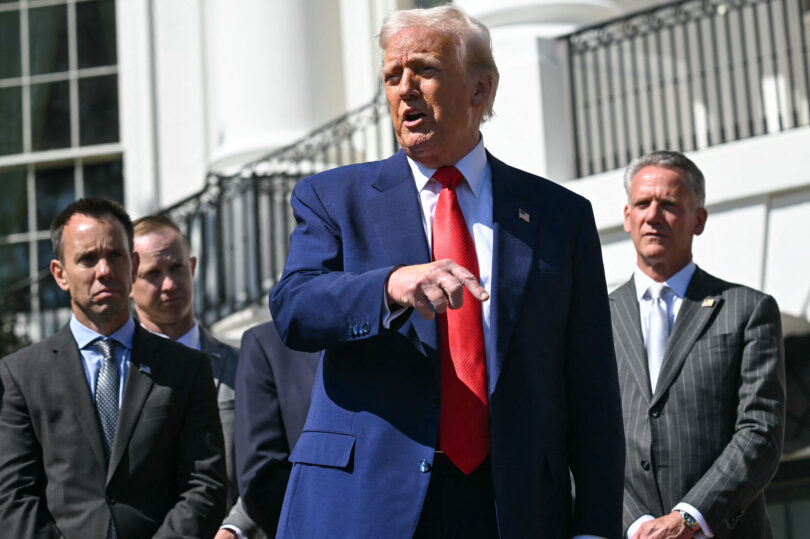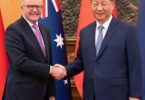Trump’s trade war causes confusion in US bond markets
Washington, United Statesusgovernmenttradetariffdebt
– What are we talking about? –
The sovereign bond markets are where a country’s debt is traded over a repayment horizon of up to 50 years.
Bond prices and yields move inversely to one another, meaning that the more a bond is sought after by investors, the higher its price, and the lower its yield.
Conversely, investors seek higher returns when they judge a government’s debt to be riskier, pushing up the yield.
US Treasurys have moved sharply — both up and down — since the announcement of the White House’s protectionist offensive.
When global markets crashed last week, investors initially flocked to the longer-dated US 10-year Treasury, pushing its yield down below 3.9 percent.
“During such periods, it’s common for investors to sell shares and buy government bonds as they are considered a safe-haven asset,” Hal Cook, senior investment analyst at Hargreaves Lansdown, wrote in a note to clients.
But since then, things have become trickier to decipher, with “an incredibly aggressive selloff” on US Treasury markets pushing yields back up, according to Deutsche Bank economist Jim Reid.
Bond yields have jumped in recent days, with the 10-year yield rising above 4.5 percent on Wednesday — before falling slightly after Trump abruptly reversed course and paused his administration’s “reciprocal” tariffs on all countries except China.
Speaking after his decision, Trump said he had noted the “very tricky” state of the US bonds market before his sudden climbdown.
At around 3:15 pm local time in Washington (1915 GMT), the yield on the 10-year Treasury was sitting at just under 4.4 percent, down from earlier highs but still up more than nine percent in the past three days.
The bond selloff, said Cook from Hargreaves Lansdown, adds to the evidence that Treasurys are “losing their traditional haven status.”
– Why rising yields are surprising –
The sharp upward movement in US Treasury yields caught some investors by surprise, given their historical role as a safe haven asset during times of market turbulence.
This movement, said Susannah Streeter from Hargreaves Lansdown, suggests some positions are being abandoned to cover losses elsewhere in the financial markets.
The same phenomenon was seen last Friday for gold, considered the ultimate safe-haven asset in times of crisis, with the yellow metal slumping from a recent all-time high reached in early April.
“Treasuries are typically the most liquid asset large investors hold, outside of physical cash,” said Hal Cook from Hargreaves Lansdown.
“It’s possible that uncertainty about future US government tax and spending policy is also part of the reason,” he added.
The spectre of a US recession due to the tariffs is also influencing the situation, according to Aurélien Buffault, bond manager at Delubac AM.
Long-dated Treasury yields like the 10- and 30-year depend on the outlook for growth and inflation, and generally fall when the outlook darkens, he said.
Short-term bonds of less than two years are heavily influenced by expectations of rate cuts or hikes by the US Federal Reserve.
But given the current uncertainty, it is difficult to predict the Fed’s next move.
That’s because monetary policymakers must now weigh the risks of both higher inflation and lower growth due to tariffs, putting them in a bind about whether to focus on the inflation or the unemployment side of the Fed’s dual mandate.
– What do surging yields mean? –
For Kathleen Brooks, research director at XTB, the answer is simple.
“Bonds are no longer a safe haven in the current market selloff,” she said.
“There is nothing systemic about this,” US Treasury Secretary Scott Bessent told Fox Business in an interview earlier in the day, before Trump changed course on the so-called “reciprocal” tariffs.
“I think that it is an uncomfortable but normal deleveraging that’s going on in the bond market,” he added.
Whether the surge in yields is technical or a broader vote of no confidence in US markets “doesn’t matter,” noted Stephen Innes, managing partner at SPI Asset Management.
“The takeaway’s the same,” he said. “The old playbook of ‘buy bonds, buy dollars’ during stress? Not working.”
emb/alb/soe/LyS/da/tgb
© Agence France-Presse







